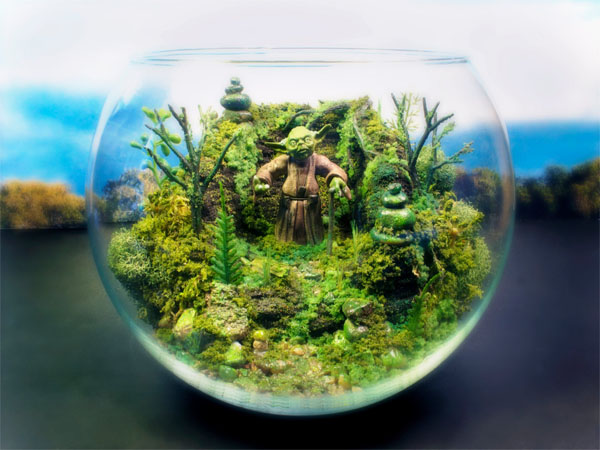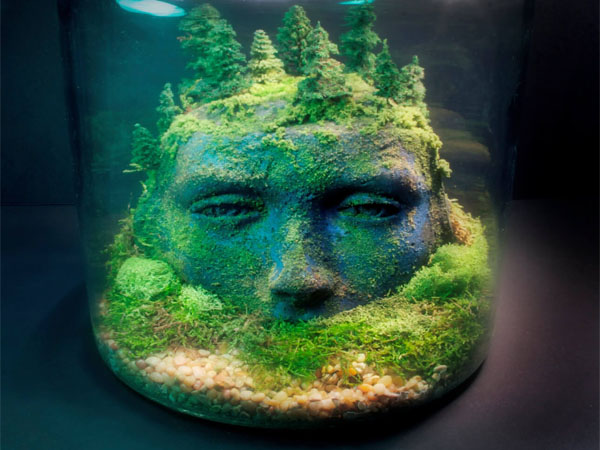Recently, we have seen a lot of terrariums mushrooming, whether in portfolios of designers or in catalogs for the home. But why are they really so attractive? It’s very simple: they are practical and have style!
Terrariums require very little water, do not take much space and are usually very easy to maintain – especially for those of us who really do not have a green thumb. These small green buttons generate interest and give life to your space way much better than could do any potted plant.
Terrariums had their first heyday during the Victorian era, after Nathanial Ward has pushed inadvertently grass in a glass box. They enjoyed a revival in the 1970s, even though at the time they were rather bulky or do not separate their suspension macrame.
Today, terrariums have an elegant and sober style and give the rooms in which they are placed a touch of whimsy. They can take many forms and sizes and are often open on top but can also have a lid.
Build your own terrarium is relatively easy. Here’s what you need:
• A glass container
• Decorative stones or rocks
• Coal for horticulture (can be in garden centers)
• A coffee filter or sphagnum moss
• potting soil (the substrate used for cacti works well)
• Miniature plants and / or foam
When choosing your container, be sure to take clear glass required to pass light. Any shape may be suitable but it is best to choose a container of at least 15 cm high in order to have sufficient space for the soil and irrigate properly.
And to make it all a little easier, it is preferable that the opening is wide enough to let your hand.
To begin, gently place 2.5 to 5 cm stones at the base of the container. The stones will allow the water to flow.
Add a thin coal seam just above the layer of stones. The charcoal acts as a filter and prevents moisture from stagnating.
To prevent the soil to come down and mix with the stones, add a ‘barrier’. You can use a coffee filter or sphagnum moss. The choice between the two depends on your personal taste and the size of your pot (the foam takes more space). If you use a coffee filter, it is better you cut it to adapt its shape to that of your container. If using foam, in use just enough to cover the carbon layer underneath.
Once this barrier is in place, add about 7.5 to 10 cm previously wetland. You can use a funnel that you will make from newsprint to lead the land where you want it to instead. This will avoid soiling the glass.
And now, the most fun part: the addition of plants. Your selection will depend on the terrarium you choose, as either open or closed. Closed terrariums require plants that love moisture. Also keep in mind that closed terrariums can not be placed in direct or semi-direct light (plants burn). You will need to choose plants that like shade.
Make sure the plants you use are not attacked by insects. If you notice any bugs, do the necessary to rid the plant before placing in the terrarium. Take advice from your garden center for the best way to eradicate them.
Open terrariums have more options because the plants can be placed moderate or strong light and can be planted in wet or more dry land. Almost all forms of miniature potted plants suit.
To install your plant, simply make a hole in the ground to make room for the roots and remove the plant. It is better that the leaves do not touch the glass walls as leaves may decompose. Depending on the size of your container, it may want to add more than one plant. That said, do not place a single plant in the terrarium can be an effective focal point. Start perhaps with only a plant, and then see if there is need to add others.
Fun House Furnishings & Design
To give more relief to the landscape of your terrarium, you can add one or two most imposing stones.
Once all in place, you can add small pebbles to cover the land or leave visible, naturally.
The closed terrariums require little care because over time, they create their own ecosystem. If plants begin to wilt and the soil air dry to the touch, you can add water gradually. You can do it with such a pear (kitchen utensil).
Once you see the water dripping at the stones at the base of the container, stop watering. One of the fastest ways to kill plants in a terrarium is overwatering. Always prefer a little dryness in too much water.
If condensation appears or small drops of water form is that the terrarium is too wet. You can solve this problem by removing the cover for a few hours.
Open terrariums require as much care as potted plants but keep in mind that the container will not let the water run so do not water too.
The plants you have chosen will dictate whether the land should remain wet or dry, so follow the instructions supplied with the plant. When watering, follow the same advice as for closed terrariums – add water until it reaches the rocks below the earth then stop.
It remains for you to enjoy your new miniature garden.








